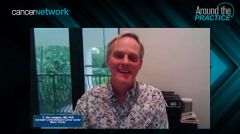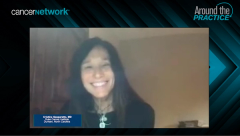
Patient Case #2: A 77-Year-Old Man With Newly Diagnosed MM
Panelists discuss the case of a 77-year-old man with newly diagnosed multiple myeloma who wishes to discontinue therapy after achieving a very good partial response.
Episodes in this series

Transcript:
C. Ola Landgren, MD, PhD:We’d like to hear a little about this case, as we talked about. This was a 77-year-old man with past medical history of ischemic heart disease, 2 cardiac stents placed 2 years ago, hyperlipidemia controlled with statins, who is former smoker with BPH [benign prostatic hyperplasia]. Also, he has performance status of 1. His R-ISS [Revised International Staging System] stage is also II. Hyperdiploidy is the FISH [fluorescence in situ hybridization] and cytogenetics. Patient is not suffering from any symptoms. Patient is deemed transplant ineligible by the treatment team. Patient has received 6 months of DRd [daratumumab, lenalidomide, dexamethasone] and obtained a VGPR [very good partial response]. He tolerated therapy well. He wants to stop the therapy and asks for your opinion. What do you think about this, Cristina? What would you do if this patient came to your clinic? Would you say that it’s OK to stop the therapy, or would you say that even this VGPR, we have added a good response, you should keep on going? How would you deal with this?
Cristina Gasparetto, MD: First, I’d try to understand why he wants to stop therapy. It’s clear that we have lots of data proving that continuation is important, so stopping at 6 cycles on VGPR—we know we’re going to run into trouble relatively soon, so we want to keep the response of the VGPR and maybe even better longer. I’d try to investigate why he wants to stop therapy: toxicity, convenience—what’s the problem? Maybe I’d try to persuade him to de-escalate and keep therapy ongoing, at least. As you mentioned on the MAIA study, there were several patients who came off the lenalidomide but were able to sustain the daratumumab monthly, and they continued to maintain the response for several months. I’ll try to investigate that and figure that out and then make my recommendation. Ultimately, I listen to the patients all the time, and I try to accommodate—try to understand their point of view. But I’ll try to give my best recommendation of continuing therapy.
C. Ola Landgren, MD, PhD:We talked about how the trials have been designed and how they’ve been done. Peter, I think you said if you want to obtain the same results, we have to unfortunately stick with the recipe of the trial. This patient is 77 years old. If he came to you, Pete, and you were the 1 who was going to give him the DRd [daratumumab, lenalidomide, dexamethasone] regimen, the MAIA study used 25 mg of Revlimid. Would you give that and then dose reduce, or would you start at the lower dose with Revlimid right away?
Peter Voorhees, MD: There’s a high probability that I would not use a 25-mg dose in a 77-year-old patient. I don’t like to use age as the basis for assessment of frailty, but odds are, someone in their late 70s is probably going to have some features of frailty, in which case a 15-mg dose of lenalidomide [is better] to start with. The IMWG [International Myeloma Working Group] has some nice guidance as far as starting doses for frailer patients of various therapies. In a situation like this, I’d probably use an intermediate dose of lenalidomide, and I’d use a 20-mg initial dose of dexamethasone as opposed to 40 mg.
C. Ola Landgren, MD, PhD:Let’s say that this patient comes to you, and we don’t know exactly how much disease he had in the beginning. Let’s make up a scenario. Say that because he’s hyperdiploid, many times they can have a lot of disease and not have symptoms. I’m sure you’ve seen the same, like 60% to 80% plasma cells, and they’re hyperdiploid and older. We give him DRd [daratumumab, lenalidomide, dexamethasone] and say it goes from 80% down to 15%. You do a bone marrow biopsy or someone has done it, and they come to you and it’s showing 15%, but they’re still light chain restricted. He has a VGPR and he says, “I want to stop therapy unless you tell me I have to.” What would you tell this gentleman, Peter?
Peter Voorhees, MD: He’s a 77-year-old. It’s a related question to what Cristina was talking about. If you want to maintain your response for longer, you should try to stay on therapy with the caveat that you’re able to do so without negatively impacting one’s quality of life. Whether that has to do with adverse-effect burden related to treatment or financial toxicity of therapy, all those things—like treatment fatigue—are important considerations to account for when you’re discussing things with the patient. But if there’s a way forward to manage adverse effects appropriately so the patient can enjoy a good quality of life and remain on therapy, that’s the path I would recommend.
C. Ola Landgren, MD, PhD:Craig, if this patient came to you and said, “I’m 77 years old. I do whatever I want. I don’t want to do all these infusions or injections with antibodies. I just want to take a tablet and live as close to a normal life as possible. Just give me the lenalidomide.” Would you do that?
Craig Hofmeister, MD, MPH: Yes, I see this patient all the time. Even though it’s 10% of MAIA, these people have really bad fatigue on monthly daratumumab and lenalidomide, and I don’t know which drug is causing the horrendous fatigue. Every time I try this, I stop 1 and then I stop the other, and the fatigue basically continues. No matter what I do, I’m lost. I find it very challenging to know what to stop so that I can keep the patient on some type of treatment. I don’t know which is better. I never know what’s causing the fatigue. I find this very confusing. If they have diarrhea as the primary thing, then I’m guessing it’s not the daratumumab. Otherwise, I blame the daratumumab for overwhelming fatigue and stop it for a while. I struggle with these patients. I’m interested in some guidance from the panelists on what to do because I’m chock-full of this 77-year-old patient with ischemic cardiomyopathy who has unendurable fatigue and wants to stop.
C. Ola Landgren, MD, PhD:I don’t know if I know the answer either. With this patient, I don’t know the answer to that question. You’re ahead of me. I was going to ask you after you’danswered what would you do if he wanted to switch to daratumumab, but you already answered that question; you don’t know. You said yes to both because you didn’t know which was better, so you’d probably try both, right? In my practice, I’ve had a lot of patients where I had a lot of them go to single-drug maintenance after combination therapy, even if the trial didn’t do that. I don’t follow the rules as hard as Peter does. I’ve tried to tease you a little, Peter, and point out the relative dose intensity was not 100%. I’ve also used daratumumab once a month for patients who have a lot of diarrhea issues with Revlimid. I like that as a great maintenance drug. I’m being completely unorthodox because of the trial you and I did, Craig. When you and I were first lassoed for the daratumumab smoldering [multiple myeloma] trial [CENTAURUS]—and I think Peter and Cristina, you were on that too—we gave it every other month. I’ve had patients who don’t want to take anything, but I persuaded them to do at least daratumumab every other month. I’ve used that for some patients as maintenance, as another alternative. I don’t know if you’ve done that. Is that something you’ve done?
Craig Hofmeister, MD, MPH: Yes, I’ve done every other month. I’ve paid patients cash to stay on treatment. I’ve done just about anything to keep people on some type of treatment, especially for lenalidomide, because the dose amount at 10 mg or above I don’t think matters. Anything is better than nothing.
Transcript edited for clarity.
Newsletter
Stay up to date on recent advances in the multidisciplinary approach to cancer.





































































































